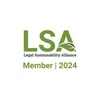FAQs: Trade Marks
Delve deeper into the various aspects of trade mark law with our frequently asked questions. This resource answers your queries about trade marks, clarifying the definition of a trade mark, the application process, its protective scope, and the consequences associated with infringement.
Frequently Asked Questions #
What is a trade mark? #
A trade mark is a distinctive identifier of a company or their goods and services. It can be, for example, a logo or word or combination of both that identifies the core goods or services as originating from that business. It distinguishes a ‘brand’ from competitors. Trade marks can include shapes, sounds, holograms, letters, and numbers.
How do I register my trade mark in the UK? #
Registering a trade mark in the UK requires submitting an application to the UK Intellectual Property Office (UKIPO). The application should include a clear representation of the trade mark, a list of goods or services that the mark will represent, and payment of application fees. It is advised to conduct a search beforehand to ensure that the trade mark is not already registered with the UKIPO. It is also recommended to have trade mark attorney input in searching to ensure that the results are interpreted correctly.
The scope of monopoly granted is derived from the manner in which the mark is protected and the goods and services covered, and it is recommended to seek advice from a trade mark attorney. All too often, when professional representation is not sought, the scope of monopoly from the registration is not as broad as desired to prevent competitors from coming close.
How do I register my trade mark outside of the UK? #
There are three different routes available if you want to obtain trade mark protection outside of the UK:
National Trade Mark Registrations
You can file a national application to register a trade mark in any country or territory which is important to you. If a trade mark becomes registered in France, you will only have protection in France. As trade marks are territorial in nature, a registration will only provide protection in the particular country it is registered in, and requirements and procedures vary from country to country.
European Union Trade Mark Registrations
A European Union Trade Mark (EUTM) registration is a cost-effective way of protecting your trade mark in all 27 countries of the EU: Austria, Belgium, Bulgaria, Netherlands, Luxembourg, Croatia, Cyprus, Czech Republic, Denmark, Estonia, Finland, France, Germany, Greece, Hungary, Ireland, Italy, Latvia, Lithuania, Malta, Poland, Portugal, Romania, Slovak Republic, Slovenia, Spain and Sweden.
International Trade Mark Registrations
It’s not possible to file one single ‘worldwide’ application to register a trade mark in every country of the world. However, the World Intellectual Property Organization (WIPO) provides for an international trade mark system (also called the Madrid system) to allow brand owners to register their trade marks in multiple countries in a single application. It’s often the most cost-effective route, especially if you want to protect a mark in several countries. Each designated country under an International Trade Mark application examines the application as an equivalent national application.
How long does a trade mark last? #
A trade mark registration typically lasts for 10 years after registration. Still, it can be renewed in further ten-year periods and has the capability of lasting forever if renewed every ten years. In the UK, if you do not pay your renewal fee by the next renewal date, your mark will expire. However, you are allowed an extra six months from the renewal date in which to renew your registration, but you will have to pay a fee for late renewal. Following this six-month period, there is a further six-month period, i.e. a total of up to one year after the renewal date, in which you may apply to restore your mark.
What is the difference between TM and ® symbols, and when can they be used? #
Ultimately, the jurisdictional positions regarding the use of TM and ® symbols differ from country to country. If you are considering trading across multiple countries, you must take care when and how these symbols are used, incorrect use can lead to legal liability. When in doubt, it is best to ensure first that you are sitting on the safe side of the fence.
TM symbol: Generally, the “™” means that the user is claiming rights to the brand without registering the mark. Or this can be used when the trade mark is not yet registered. The TM symbol has no legal significance in the UK. This means that there is no limitation as to when it can be used; the TM symbol can accompany any registered or unregistered mark.
® symbol: In contrast, the ® symbol can only be used by owners of a trade mark that has been registered in the UK. Notably, using the ® symbol or the word ‘registered’ to falsely indicate registration of a mark that is unregistered constitutes a criminal offence under section 95 of the Trade Marks Act 1994.
There is no legal requirement for a registered trade mark to be accompanied by a TM or ® symbol to indicate registration. A registered trade mark is due the same level of legal protection, regardless of whether the TM or ® symbol accompanies it
Can I trade mark a business name? #
Yes, it is possible to register a trade mark for a business name, provided it satisfies the necessary trade mark requirements. One key requirement is that the name should be unique and distinctive, setting it apart from other trade marks. Additionally, it is important to ensure that the chosen business name does not cause any confusion or conflict with existing trade marks already in use. Taking these factors into account will help protect the brand identity and reputation associated with the business name
What is trade mark infringement? #
Trade mark infringement occurs when an entity uses a trade mark that conflicts with a registered trade mark. Generally, this occurs if the trade mark used by the third-party is identical or confusingly similar to a registered trade mark, without the owner's permission, in relation to products or services that are identical or similar to the products or services of the registered trade mark. It can also arise for dissimilar goods or services if the registered trade mark has a reputation. This unauthorised use can cause consumer confusion, dilution of the registered trade mark's distinctiveness, and potential damage to the reputation and market position of the rightful owner. It is important for businesses to protect their trade marks through proper registration and enforcement measures to safeguard their intellectual property rights.
What can be trade marked? #
Almost anything that serves to distinguish your business and make it stand out from the competition can potentially be trade marked. This includes but is not limited to business names, product names, logos, slogans, colours, sounds, and even distinctive smells that are associated with your brand. By protecting these unique elements through trade mark registration, you can establish a strong and recognisable identity for your business, ensuring that it is easily identifiable and memorable to consumers.
What is the benefit of registering a trade mark? #
Registering your trade mark creates a defined right in your brand, arising from a defined and is a business asset. It makes it easier to take action against third parties using the same or similar trade marks. It also means that your trade mark is on a searchable register, which could deter others from adapting something similar or identical. The defined right through registration creates clarity if the trade mark is to be sold, licenced or franchised.
It is possible to gain “unregistered rights” of a trade mark by using it over time. However, these take time to build up and are restricted to actual use, both on goods and services and geographically. You do not, therefore, have the benefit of a formal national registration, which can be filed for goods and services you also anticipate expanding into when seeking to prevent third parties from using your trade mark. Registration is, therefore, generally more straightforward and can save you money in the long run.
How much does it cost to register a trade mark? #
The cost of registering a trade mark can vary significantly depending on the jurisdiction and the number of classes of goods or services for which the mark will be registered. In the United Kingdom, for example, the initial application fee for one class of goods or services is £170. This fee is subject to change, and additional fees may apply for multiple classes or additional services related to the registration process. It is essential to consult a trade mark attorney to obtain accurate and up-to-date information on the cost of registering a trade mark in a specific jurisdiction and the scope of monopoly you seek to obtain.
Can I sell or transfer my trade mark? #
Yes, a trade mark holds significant value as it can be sold, licensed, or transferred to another entity and even mortgaged if it has value. This will typically involve a formal agreement, and in certain scenarios, it is necessary to record the transfer with the trade mark office for legal purposes. By effectively managing and leveraging trade marks, businesses can maximise their intellectual property assets and explore various opportunities for growth and expansion.




















